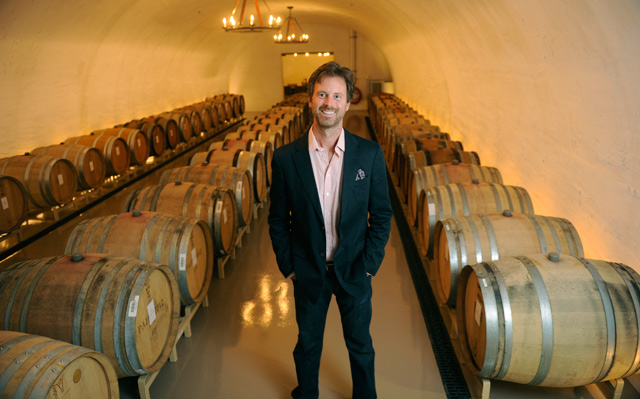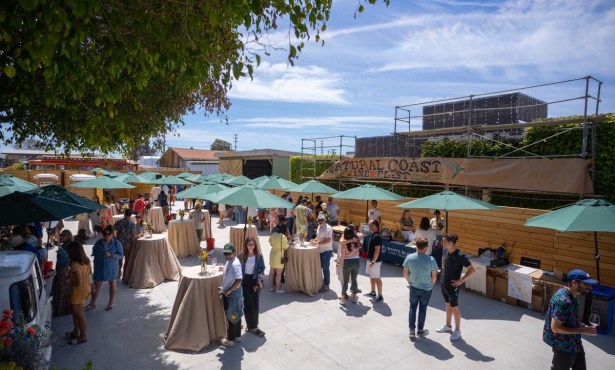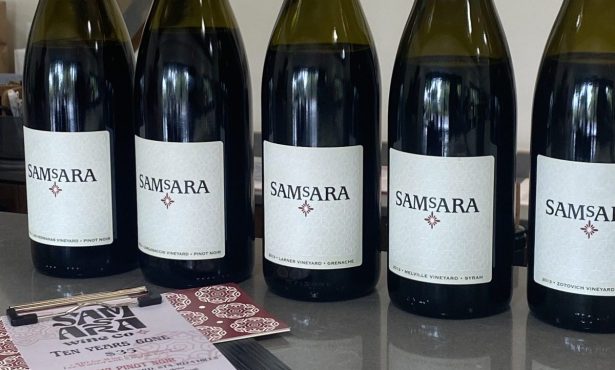LaBarge Winery Employs Meticulous Control
Upscale Sta. Rita Hills Project Spares No Expense in Producing Albariño, Pinot Noir, and More

There’s bound to be a bit of healthy suspicion when a brand-new winery comes out of the gates charging $60 for a bottle of a rarely planted white wine grape from Spain called albariño, not to mention $100 for pinot noir and cool-climate expressions of syrah and grenache. But the reasons why reveal themselves within seconds of walking into LaBarge Winery, where meticulous control over grape-growing, winemaking, and even sales and marketing meet with the dedication to a classical elegance that only old money can achieve.
Located on the westernmost flank of the Sta. Rita Hills, atop a bend in Sweeney Canyon Road, with views of Lompoc, the Santa Ynez River, and the waves of Surf Beach in the deep distance, LaBarge’s facility was one of the last projects designed by renowned Santa Barbara architect Barry Berkus, whose reverence to Spanish Colonial Revival is only upstaged by his subtle mastery of modern touches. Laid out on a cross of sorts that adheres to the four cardinal directions, the main room features a glass floor with views into the barrel room below and a large glass window on the adjacent wall, looking directly into the active winery itself.
“The idea was to stand here and see the whole process,” said proprietor Pierre LaBarge IV, 35 years old, a scion of the St. Louis family that made fortunes in defense contracting and steel pipe sales. “It’s a very private facility,” he replies when I ask if he ever plans to open his masterpiece to the public. “We feel like it’s our house.”
And for about three months of the year, it is in fact where the otherwise resident of Santa Barbara’s Mesa neighborhood sleeps while he manages harvest. Unlike so-called “vintners” who merely put up the cash and watch the wine flow, LaBarge is the hands-on winemaker on each part of the process, from vineyard plotting to racking barrels to washing down the winery, which is impeccably clean. “Sanitation is our biggest thing here,” said LaBarge, to which Brad Potter, LaBarge’s sales and marketing man, adds, “We’re all professional moppers.”
I first met LaBarge in 2014 at a private Portuguese-style St. Valentine’s dinner in Napa, where we dined on bacalhau and listened to Azorean folk guitar with a handful of the top Santa Barbara County winemakers as well as legendary wine critic Robert Parker. Well-dressed, expertly mannered, and articulate then as now, LaBarge only slightly exhibits the airs that come from dynastic wealth, perhaps because his path to winemaking was as down-to-earth as it gets.
After graduating from Holy Cross, LaBarge moved to San Diego, realized he didn’t want a desk job, and started working at Fallbrook Winery, where he caught the bug. After meeting the woman who would become his wife (and mother of their son, Pierre V), they moved to San Luis Obispo, where LaBarge got a master of science in soil science and viticulture. He then worked at Shadow Canyon in Paso Robles’s York Mountain AVA, and for Ventura’s legendary Manfred Krankl, whose Sine Qua Non is arguably the most expensive American wine in the world.
In 2009, with help from his dad — whose love of good wine opened Pierre’s eyes at a young age —LaBarge purchased the estate as well as another vineyard located in the heart of the Sta. Rita Hills, between Fe Ciega and Mt. Carmel vineyards. The next year, he started planting pinot noir, of course, but grenache and syrah, as well. And based on a homocline analysis that showed the Sta. Rita Hills is most like Rías Baixas, the chilly region of northwestern Spain that’s the ancestral home of albariño, LaBarge decided to plant that grape, as well.
He was also excited to try albariño because he didn’t have much experience tasting it, so there was no benchmark to really achieve. “It’s a really clean slate for me,” said LaBarge, who’s experimented with allowing it to go through malolactic fermentation. “I think we’ve benefitted from that.” Additionally, replicating Rías Baixas is not his goal. “I don’t really want people to think of this as an albariño or even an albariño from the Sta. Rita Hills,” he said. “I just want people to think that this is LaBarge’s white wine.” He’s already expanded his plantings of the grape, hoping to eventually get to 200 cases annually.
His reds, meanwhile, are intensely structured, much more so than most other Sta. Rita Hills bottlings, and walk the balance beam between ripeness and freshness. “Our path is the classical middle,” said LaBarge, when we discuss the modern poles of pinot noir and Rhône winemaking in California, from juicy and rich to sparse and sprightly. “We don’t want to stick out on either end.”
So far, the released wines — including the 2014 albariño, 2013 and 2014 pinot noir, and the 2012 and 2013 syrah, with the 2015 albariño and 2014 grenache coming next spring — drink well now, but have the bones to live an extremely long time in the cellar. You won’t be able to find the wine in a store, but the online wine club is growing, and their restaurant distribution is strategic to New York, Florida, Missouri, and Southern California, including at San Ysidro Ranch and Lucky’s in Montecito and bouchon and La Cumbre Country Club in Santa Barbara. With plans to never exceed 1,500 cases per year — and a commitment to complete control that even includes the winery’s own bottling line, a luxurious rarity even for much larger wineries — it shouldn’t be too hard finding a steady high-minded market for these well-tended wines.
What LaBarge enjoys most is succeeding against the odds, as many experts thought some of his plans idiotic. “That’s the most rewarding thing,” said LaBarge, “hearing things like that and getting a positive result.”
See labargewinery.com.



